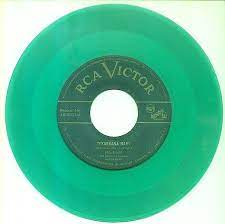In the annals of music history, 1949 marked a significant milestone with the introduction of the first vinyl record in the 45 revolutions per minute (rpm) format. This innovation, which forever altered the way music was produced, distributed, and consumed, became a cornerstone of the music industry and contributed to the rise of popular culture in the post-war era. The 45 rpm vinyl record, often simply referred to as the "45," was developed by RCA Victor in response to the demand for a smaller, more durable, and higher-fidelity alternative to the standard 78 rpm shellac records. The 78s had been the dominant format for recorded music since the early 20th century but were bulky, fragile, and limited in their capacity to capture the nuances of sound. Introduced in March 1949, the 45 rpm record offered a new paradigm for both artists and consumers. Its smaller size not only made it more manageable but also allowed for a single song to be featured on each side. This format was a game-changer for the music industry, as it facilitated the rise of the single as the primary mode of music consumption. Artists and record labels quickly adapted to this new format, releasing hit songs on 45s that became a staple of jukeboxes and home record players. One of the most significant advantages of the 45 rpm record was its improved sound quality. The use of vinyl as a recording material allowed for a quieter surface noise, increased durability, and enhanced fidelity compared to shellac. The wider grooves and slower speed of 45 rpm records enabled more accurate reproduction of the original recording, capturing a broader range of frequencies and nuances in the music. This technological leap contributed to a more enjoyable and immersive listening experience for music enthusiasts. The adoption of the 45 rpm format had profound implications for the music industry's business model. With the rise of singles, artists could release individual tracks independently of a full album, allowing for a quicker turnover of new material. This shift in focus from albums to singles paved the way for the development of the pop music landscape, with artists striving to create hit songs that could top the charts and capture the public's attention. The 45 rpm record became the standard for popular music throughout the 1950s and 1960s. It played a crucial role in the emergence of rock and roll, rhythm and blues, and other genres that defined the era. Iconic singles from artists like Elvis Presley, Chuck Berry, and Little Richard became emblematic of the 45's cultural significance, influencing the trajectory of music and popular culture. While subsequent developments in music technology, such as the introduction of the long-playing (LP) record and the compact disc (CD), would reshape the industry, the 45 rpm record remains a symbol of a transformative period in music history. Its impact on the way we consume and experience music endures, and the introduction of the 45 rpm vinyl record in 1949 remains a pivotal moment that shaped the trajectory of the music industry for decades to come.
1949 First Vinyl Record (45 rpm)
